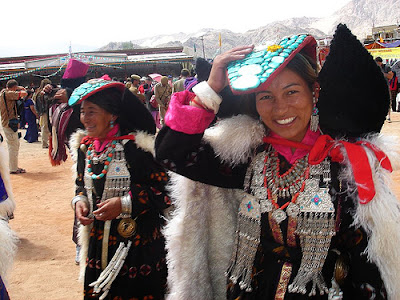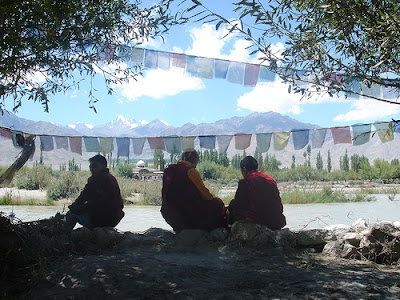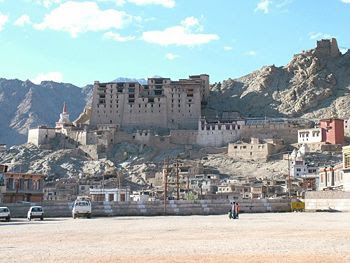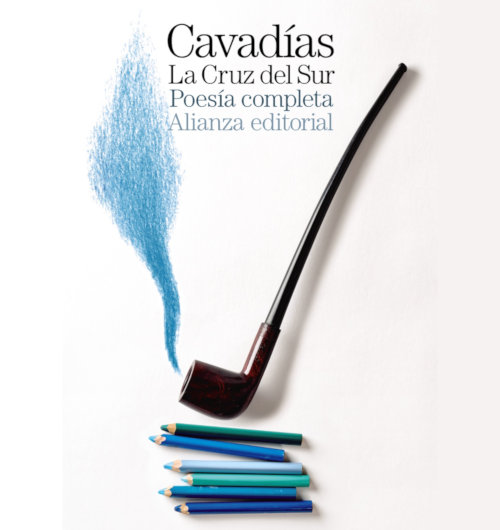Leh, Ladakh
This morning I heard drums outside the guest house. Tsering said because it is the first day of Ladakhi Losar (the New Year celebration which ends on the 10th), the traditional drummers are making the rounds.
it is the first day of Ladakhi Losar (the New Year celebration which ends on the 10th), the traditional drummers are making the rounds.
Ladakh has its own sort of Buddhist caste system, and musicians are a distinct group known as the Mon. Dancers, singers and musicians used to be a separate caste in most parts of India. Tsering said they go around playing the daman (drum) and surna (a kind of clarinet or shenai) in every neighborhood asking for money.
"In the old days," he said, "we used to give only tsampa (barley) powder, chappati, food, like that. Now we are expected to give some cash," he smiled. How much? "Oh, ten, twenty rupees, like that." So it's a bit like Ladakhi trick-or-treating.
The little things
I'm looking to fly outta here in the next week or so. Strangely, it is the same fare to fly to Jammu (and take the bus to Dharamsala) as to fly directly to Delhi.
Suddenly, all the signature little Ladakhi things I have come to take for granted for the past three and a half months are now jumping out at me. Even just sitting here typing and looking out the cybershop window, I see so many "little things" that are (perhaps unfortunately) Only In Ladakh.
-a single file line of fuzzy grey donkeys, their colour identical to that of the surrounding mountains, trudging slowly up the street in search of some prime scavenging. They always remind me of the manger scene in the Christmas Story.
-Bright new private school buses full of immaculate children in maroon blazers with matching knit caps, which match their apple cheeks. (The government school students and their buses don't look quite as new and shiny, naturally. Same healthy apple cheeks, though.)
-Delivery trucks whizzing by with letters hand painted in both blocky English and flowery Urdu script
-NO beggars on the street. This is not necessarily "only in Ladakh." Yes, I have certainly been in plenty of other small Indian towns, particularly in the South, that also have no beggars. But this is downtown in a major city - that is unusual.
In fact, there are a few beggars here in the summer time (high season for tourists). They all come from outside Ladakh, and they all move on (following the tourists) in November.
-Almost NO child labour to speak of. There are a (very) few under-16s that are working. I noticed that all of  them are from Bihar, Nepal or UP. The brief conversations we were able to have (in my bad Hindi) confirmed this.
them are from Bihar, Nepal or UP. The brief conversations we were able to have (in my bad Hindi) confirmed this. There is a 14 year old "doing for" Mr Yassin's auntie. He sleeps in their hallway. He stands out among the Ladakhis like a palm tree in New England maples. When I asked him "kahan se?" he said he is from a village called "Goondar" in Uttar Pradesh. He may even be younger than 14. He still hasn't lost his sweet, shy smile.
Though I don't envy his life, I have to think he's better off here than labouring somewhere in his home state. It's just a much gentler place in general. How else can one explain the Rajasthani shoemaker who has set up business on the corner with his two tiny children - one girl, one boy? It must be unbelievably cold for them here. I would love to find out what drove him so far from Rajasthan and what keeps him here.
-Bactrian Magpies- enormous black-and-white birds, the size of large crows but prettier, and native only to this area.
-Young Kashmiri and Ladakhi Muslim men, all with full beards and wearing the Kashmiri poncho-type overcoat, pushing the water dollies up and down the roads.
-Old men and women selling baskets of dried apricots -- with faces that look also like dried apricots. Also, classic-looking elder men sitting in the afternoon sun in front of the mosque, with faces, hats, beards, and robes that bring to mind romanticized images of Silk Road traders.
-Glancing upward from almost anywhere around town and seeing the 400 year old Leh Palace originally built by (or rather, for) King Singge Namgyal. It's like a little mini- Potala just minutes away (in fact it is said to have been modeled on the Potala. Another version I heard said the Potala was modeled on Leh Palace!) (the Palace photo above is from Wikipedia).
Potala just minutes away (in fact it is said to have been modeled on the Potala. Another version I heard said the Potala was modeled on Leh Palace!) (the Palace photo above is from Wikipedia).
Higher still is the Tsemo Gompa, looking like a kid's bucket sandcastle after a wave hit it. A lone monk still climbs up once every morning and evening to look after the shrines and light lamps in the crumbling former monastery.
I have climbed the hill (in Tamil Nadu they would call it a mountain) a few times, and can only imagine what it was like hauling the bricks up there...400 years ago.
-Moonlight bouncing off the snowcapped mountains that surround the city
-Hitchhiking (still acceptable, common and safe here) . Distances are vast, and it's rare that a driver does not stop. Sometimes on a deserted road, drivers even stop voluntarily to ask if you are "okay." (No, it is not just because I am a foreign female - almost everyone thumbs a ride here in Ladakh.)
-Cheerful, confident women of all ages striding down the street, unaccompanied by men, with none of the "please don't hit me" body language shared by so many Indian women.
The young ladies coming home from school wear crested school blazers, baseball caps and slacks; older married women wear full-skirted gonchas with embroidered Kashmir shawls draped elegantly round their shouders. Unmarried young women wear Indian salwar-kameez, sweaters and shawls. They seem very uninhibited in their movements.
-Single women running businesses, including restaurants, all on their own. No men in sight. No one says anything, no one hassles them, and nobody blinks an eye.
-The hum of the noisy red kerosene generators. Since there is no power during the day, a few choice businesses have these alternative sources of power, which is the only reason I am typing now!
-Big piles of fur lining the sidewalks, in the form of peaceful, sleeping street dogs. The Leh Street Dog Program (sponsored by a French NGO) has taken care of many of them. It's so nice to see street dogs with healthy, fluffy fur - *not* riddled with mange and other skin diseases. They generally seem much less hassled than street dogs elsewhere.
You can identify the rabies-inoculated, spayed and neutered street dogs fairly easily. The Program takes a small triangular notch out of their ear, while they are still under anesthesia.
-The call of the mosque's muezzin, reminding the faithful to attend prayer 5 times a day. Since there are 2 major mosques here (Sunni and Shia), we actually hear the muezzin's call 10 times a day....the Shias go first, then about 15 minutes later we hear the Sunni muezzin. It's not always the same guys doing the call and some definitely sound more practiced than others.
There is one guy who gives his "call" at about 5.30 AM. Since I don't always get up that early, I have only heard him a few times....but it is worth getting up for. He really puts some artistry into his morning songs. To hear this as the sun is rising over the mountains is a cherished Ladakhi memory.
-The wicker baskets (actually woven willow) used by the women to carry vegetables on their backs, to and from the Bazaar market.
-Having total strangers, including little kids and old women, say "Jullay" on the street, with a big smile, and just keep walking. Unlike a lot of other places, they don't want anything...not to sell me anything, or "one pen please." They are just being polite.
and last but not least....
-only washing my hair once a week. It's so cold, no one is looking and I just throw a hat on it every day, anyway!
 it is the first day of Ladakhi Losar (the New Year celebration which ends on the 10th), the traditional drummers are making the rounds.
it is the first day of Ladakhi Losar (the New Year celebration which ends on the 10th), the traditional drummers are making the rounds.  them are from Bihar, Nepal or UP. The brief conversations we were able to have (in my bad Hindi) confirmed this.
them are from Bihar, Nepal or UP. The brief conversations we were able to have (in my bad Hindi) confirmed this. Potala just minutes away (in fact it is said to have been modeled on the Potala. Another version I heard said the Potala was modeled on Leh Palace!) (the Palace photo above is from Wikipedia).
Potala just minutes away (in fact it is said to have been modeled on the Potala. Another version I heard said the Potala was modeled on Leh Palace!) (the Palace photo above is from Wikipedia). 













No comments:
Post a Comment